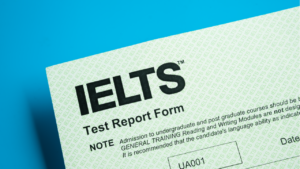The International English Language Testing System (IELTS) is a globally recognised examination designed to assess the English language proficiency of non-native English speakers.
Including four sections, the IELTS test evaluates candidates in listening, reading, writing, and speaking.
In this guide, we’ll delve into an example of the IELTS Speaking test, how to answer it, and the key points.
Format of the IELTS Speaking Test:
The IELTS Speaking test is divided into three parts, each with a specific goal of evaluating your spoken English skills.
Part 1: Introduction and Interview (4-5 minutes):
- The examiner introduces themselves and confirms your identity.
- You are then asked to introduce yourself and answer general questions about everyday topics such as home, studies, work, and interests.
Part 2: Long Turn/Cue Card (3-4 minutes; 1 minute for preparation + 2-3 minutes speaking)
- You will receive a task card with a topic and a set of prompts. For example:
| Describe a daily routine that you enjoy. You should say: What is it? Where and when do you do it? Why do you do it? Explain why you enjoy it. |
- You will be given one minute to prepare notes and organise your thoughts.
- You should speak on the given topic for 1-2 minutes, addressing all the prompts.
Part 3: Discussion (4-5 minutes):
- The examiner asks questions related to the topic from Part 2, delving deeper into your opinions and ideas.
- This section assesses your ability to express and justify opinions, analyse, and discuss abstract ideas.
Total Time Allocation: 11-13 Minutes
- Part 1: 4-5 minutes
- Part 2: 3-4 minutes (1 minute for preparation + 1-2 minutes speaking)
- Part 3: 4-5 minutes
Assessment Criteria:
You are assessed based on four criteria:
- Fluency and Coherence: How well can you maintain a flow of speech and express ideas logically.
- Lexical Resource: The range and accuracy of vocabulary used.
- Grammatical Range and Accuracy: The correct use of grammatical structures and the variety of sentence structures.
- Pronunciation: The ability to articulate sounds and convey meaning clearly.
Also read: Describe a Chocolate You Didn’t Like: IELTS Speaking Cue Card
Leap Advantage Virtual Spot Offer Event on May 10th 2024

Last call to secure your spot for Masters in STEM Program in the US for Fall ’24 exclusively for graduates and above.
Leap Advantage Virtual Spot Offer Event on May 10th 2024
Last call to secure your spot for Masters in STEM Program in the US for Fall ’24 exclusively for graduates and above.

Sample Answer: Describe a daily routine that you enjoy
Let’s see how to answer the question below:
| Describe a daily routine that you enjoy. You should say: What is it? Where and when do you do it? Why do you do it? Explain why you enjoy it. |
Let’s break down the IELTS Speaking Part 2 response for the given cue card:
Introduction:
- “One of my favourite daily routines is my morning exercise routine, which I find both energising and fulfilling.”
Explanation: The introduction provides a clear and concise overview of the daily routine being described – morning exercise.
Crack IELTS Exam in first attempt

Attend Leap’s free masterclass to get tips, tricks and advance strategies to crack IELTS exam in first attempt
Crack IELTS Exam in first attempt
Attend Leap’s free masterclass to get tips, tricks and advance strategies to crack IELTS exam in first attempt

What is it?
- “Every morning, I engage in a 30-minute workout session that combines cardio and strength training exercises.”
Explanation: This section offers a brief description of the specific activities involved in the morning exercise routine, emphasising the combination of cardio and strength training.
Where and when do you do it?
- “I typically do this routine in the comfort of my home, specifically in my living room. I usually start at around 6:30 in the morning before heading to work.”
Explanation: Details about the location (home) and timing (6:30 in the morning) add specificity to the response, enhancing the examiner’s understanding of the routine.
Why do you do it?
- “The primary reason I incorporate this routine into my daily life is to maintain a healthy and active lifestyle. Exercise not only helps me stay physically fit but also sets a positive tone for the rest of the day.”
Explanation: The response explains the primary motivation for the routine – maintaining a healthy and active lifestyle. This provides a clear purpose for the described daily activity.
Explain why you enjoy it:
- “I truly enjoy this routine because it serves as a powerful stress reliever. The rhythmic movements and the surge of endorphins not only wake me up but also enhance my mood, preparing me for the challenges ahead.”
Explanation: The explanation delves into the emotional and mental benefits of the routine, highlighting its role as a stress reliever and mood enhancer.
Also read: Describe a Person Who you Believe Dresses Well: Sample Answers
Extra Tips: How to answer Part 2 Cue Card
Introduction:
- Make it Interesting: Start by telling a short, interesting story or using lively language to grab attention. For instance, “Let me share the best part of my day that boosts my energy and starts my mornings!”
What is it?
- Add Some Flavor: When describing your routine, add specific details or talk about different things you do. Instead of saying, “I exercise in the morning,” you could say, “I do a mix of jogging and strength exercises to keep fit.”
Where and when do you do it?
- Create a Picture: Give a clear picture of where and when your routine happens. For example, “I do it in my cosy living room every day at 6:30 in the morning when everything is quiet and peaceful.”
Why do you do it?
- Connect with Values: Share why your routine is important to you personally. Instead of just saying, “I do it to stay healthy,” you could say, “It’s my way of building strength and resilience, which helps me face challenges in other parts of my life.”
Explain why you enjoy it:
- Share Feelings: Express how your routine makes you feel. Instead of just saying, “I like it,” you could say, “I love the feeling of joy and energy it gives me, like a happy boost that stays with me all day.”
By keeping it simple and adding these little details, you can make your response more interesting and show off your English skills in a friendly way!
Also read: Describe a difficult thing you did with the IELTS Cue Card
IELTS Speaking Part 3 (Follow-up Questions)
1. Examiner’s Question: How does your daily routine impact your overall well-being?
Answer:
- My daily routine significantly contributes to my overall well-being. The morning exercise, in particular, not only keeps me physically fit but also sets a positive tone for the day. The sense of accomplishment and the endorphin rush from the workout has a direct impact on my mood and energy levels, enhancing my well-being.
Explanation:
- This response elaborates on the positive impact of the described daily routine on the speaker’s well-being. It emphasises both physical fitness and psychological benefits, showcasing a comprehensive understanding of well-being.
2. Examiner’s Question: How do you think different daily routines might affect people’s stress levels?
Answer:
- Different daily routines can have varying effects on stress levels. For instance, a routine that incorporates stress-relief activities like exercise or meditation can help manage stress effectively. On the other hand, a hectic routine with little time for relaxation might contribute to higher stress levels. It ultimately depends on how well the routine aligns with an individual’s stress-coping mechanisms.
Explanation:
- This response analyses the potential impact of diverse daily routines on stress levels. It introduces the concept that the effectiveness of a routine in managing stress is subjective and depends on how well it aligns with an individual’s coping strategies.
3. Examiner’s Question: How can someone modify their routine to improve their overall lifestyle?
Answer:
- Modifying a routine to enhance lifestyle involves identifying areas for improvement. For example, if someone wants to prioritise mental well-being, incorporating activities like mindfulness or reading into their daily routine can be beneficial. It’s about finding a balance that addresses specific lifestyle goals, whether it’s physical health, mental well-being, or work-life balance.
Explanation:
- This response provides a constructive approach to modifying daily routines for lifestyle improvement. It suggests tailoring the routine to individual goals, demonstrating a thoughtful understanding of the relationship between routine and lifestyle.
4. Examiner’s Question: In your opinion, how do cultural differences influence daily routines?
Answer:
- Cultural differences play a significant role in shaping daily routines. For instance, in some cultures, communal activities or family time may be prioritized, influencing the structure of the day. Understanding cultural nuances helps individuals appreciate diverse approaches to daily life and adapt their routines accordingly.
Explanation:
- This response highlights the influence of cultural differences on daily routines. It introduces the idea that cultural values shape how people structure their time, emphasising adaptability and understanding in the context of diverse cultural practices.
5. Examiner’s Question: Do you think modern technology has changed the way people approach daily routines?
Answer:
- Modern technology has undoubtedly transformed daily routines. With smartphones and apps, people can now integrate work, communication, and leisure seamlessly into their schedules. While this offers convenience, it also blurs the boundaries between work and personal life, potentially impacting the traditional structure of daily routines.
Explanation:
- This response discusses the impact of modern technology on daily routines, addressing both the convenience and potential drawbacks. It acknowledges the transformative nature of technology and its implications on the traditional structure of daily life.
In the IELTS Speaking Part 3, it’s important to provide well-developed responses covering different aspects of the topic. These responses show a deeper understanding of the subject matter and showcase the ability to express ideas clearly.
Tips to Prepare for IELTS Speaking Test
Here are a few tips you can utilise while attempting the IELTS Speaking test:
- Practice Regularly: Engage in regular speaking practice to build confidence and improve fluency.
- Expand Vocabulary: Work on enriching your vocabulary to express ideas more precisely.
- Understand Task Types: Know the different task types in each test part.
- Record Yourself: Record your responses to identify areas for improvement, especially in pronunciation and fluency.
- Stay Calm and Collected: Practice mindfulness techniques to manage nervousness and maintain composure during the test.
Frequently Asked Questions
-
Q: What is the IELTS Speaking test, and how is it structured?
A: The IELTS Speaking test serves as a comprehensive evaluation of your ability to communicate fluently and coherently in English. It consists of three distinct parts. The Introduction and Interview section establishes a conversational tone and touches on personal topics. Following this, the Long Turn (Part 2) involves speaking on a given topic for up to two minutes, allowing you to showcase your speaking skills in a more extended format. Lastly, the Discussion (Part 3) delves deeper into broader issues related to the previous topic, requiring critical thinking and extended responses.
-
Q: How long does the IELTS Speaking test take?
A: The IELTS Speaking test is designed to be a concise yet comprehensive assessment, typically lasting between 11 to 14 minutes. This timeframe allows for a thorough evaluation of your spoken English proficiency.
-
Q: What kind of topics can be expected in Part 1 of the IELTS Speaking test?
A: Part 1 introduces a range of familiar topics designed to ease you into the speaking test. Expect questions about personal details, hobbies, daily routines, and general experiences. This section aims to create a comfortable atmosphere for the discussion.
-
Q: Is there a specific duration for each part of the IELTS Speaking test?
A: Yes, each part of the IELTS Speaking test has a predefined duration. Part 1 generally takes about 4-5 minutes, Part 2 (Long Turn/Cue Card) spans approximately 3-4 minutes, and Part 3 (Discussion) extends for around 4-5 minutes, providing a balanced assessment across various speaking scenarios.
-
Q: Can I choose the topic for Part 2 (Long Turn) of the IELTS Speaking test?
A: Part 2 introduces a task card with a designated topic. During the 1-minute preparation time, you are encouraged to take notes, after which you deliver a monologue on the assigned subject. This format assesses your ability to think on your feet and communicate coherently.
-
Q: How is the IELTS Speaking test scored?
A: The IELTS Speaking test is scored across four criteria: fluency and coherence (clarity), lexical resource (vocabulary usage), grammatical range and accuracy, and pronunciation. Each criterion contributes to an overall band score, providing a holistic assessment of your speaking proficiency.
-
Q: Can I bring notes or a script to the IELTS Speaking test?
A: The IELTS Speaking test is designed to evaluate spontaneous spoken English. As such, notes or prepared scripts are not permitted. The assessment focuses on your ability to express yourself naturally and without reliance on pre-learned material.
-
Q: Is there a specific accent expected in the IELTS Speaking test?
A: The IELTS Speaking test recognises and accommodates a variety of accents. The emphasis is on clear pronunciation and effective communication, irrespective of the natural accent you possess. Clarity and coherence are paramount.
-
Q: Can I express my personal opinions in the IELTS Speaking test?
A: Absolutely. Part 3 of the IELTS Speaking test encourages you to express and defend your personal opinions on more abstract and complex topics. This segment assesses your critical thinking skills and your ability to articulate viewpoints effectively.
-
Q: Is there a dress code for the IELTS Speaking test?
A: While there is no formal dress code, it is advisable to wear something comfortable yet appropriate for an interview-like setting. This helps create a positive impression and contributes to a confident presentation.
-
Q: Are there specific topics to avoid discussing in the IELTS Speaking test?
A: No topics are explicitly off-limits in the IELTS Speaking test. The assessment aims to evaluate your ability to express yourself on a wide array of subjects. Focus on effectively communicating your ideas and opinions, showcasing your proficiency in spoken English.







